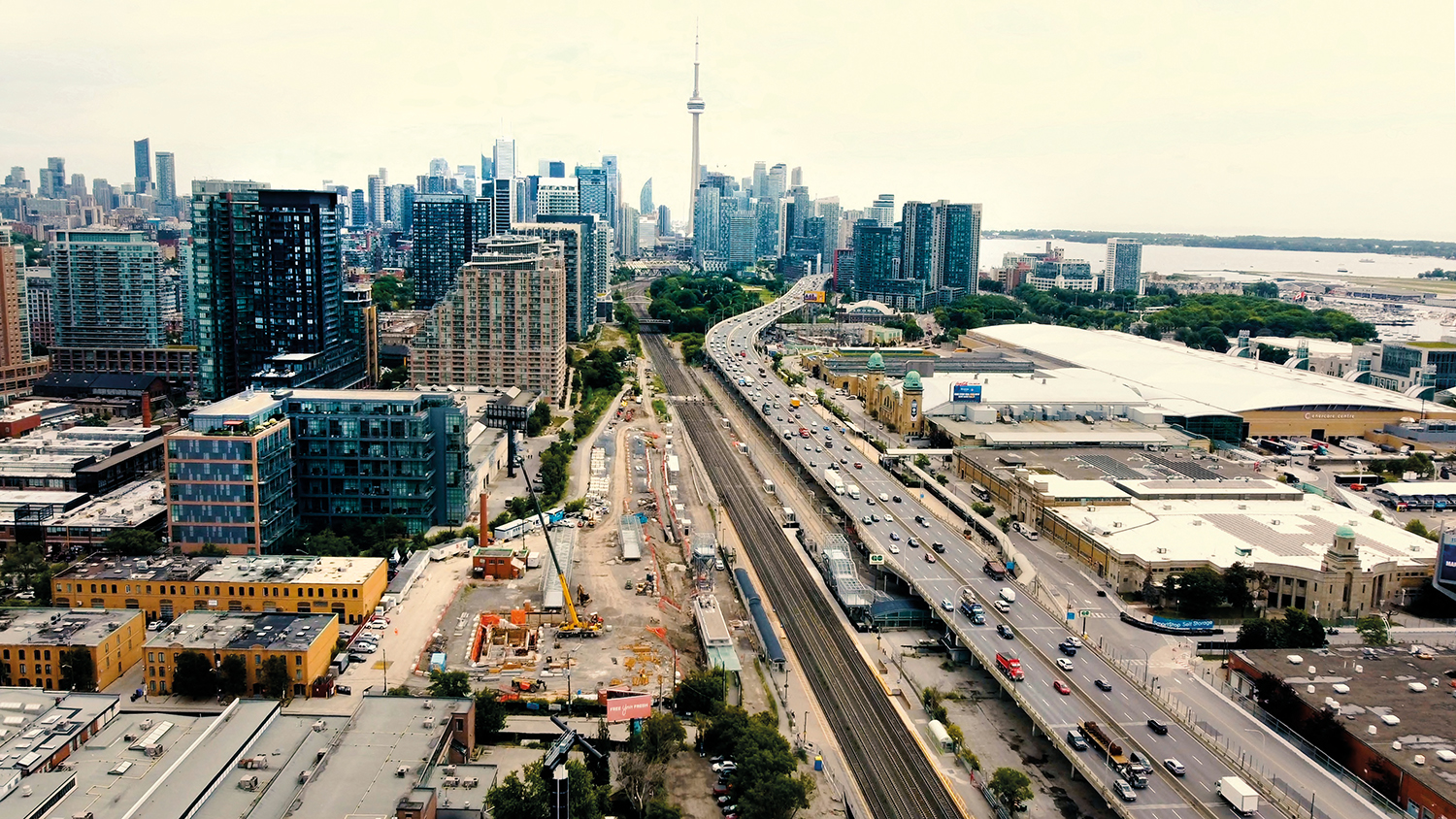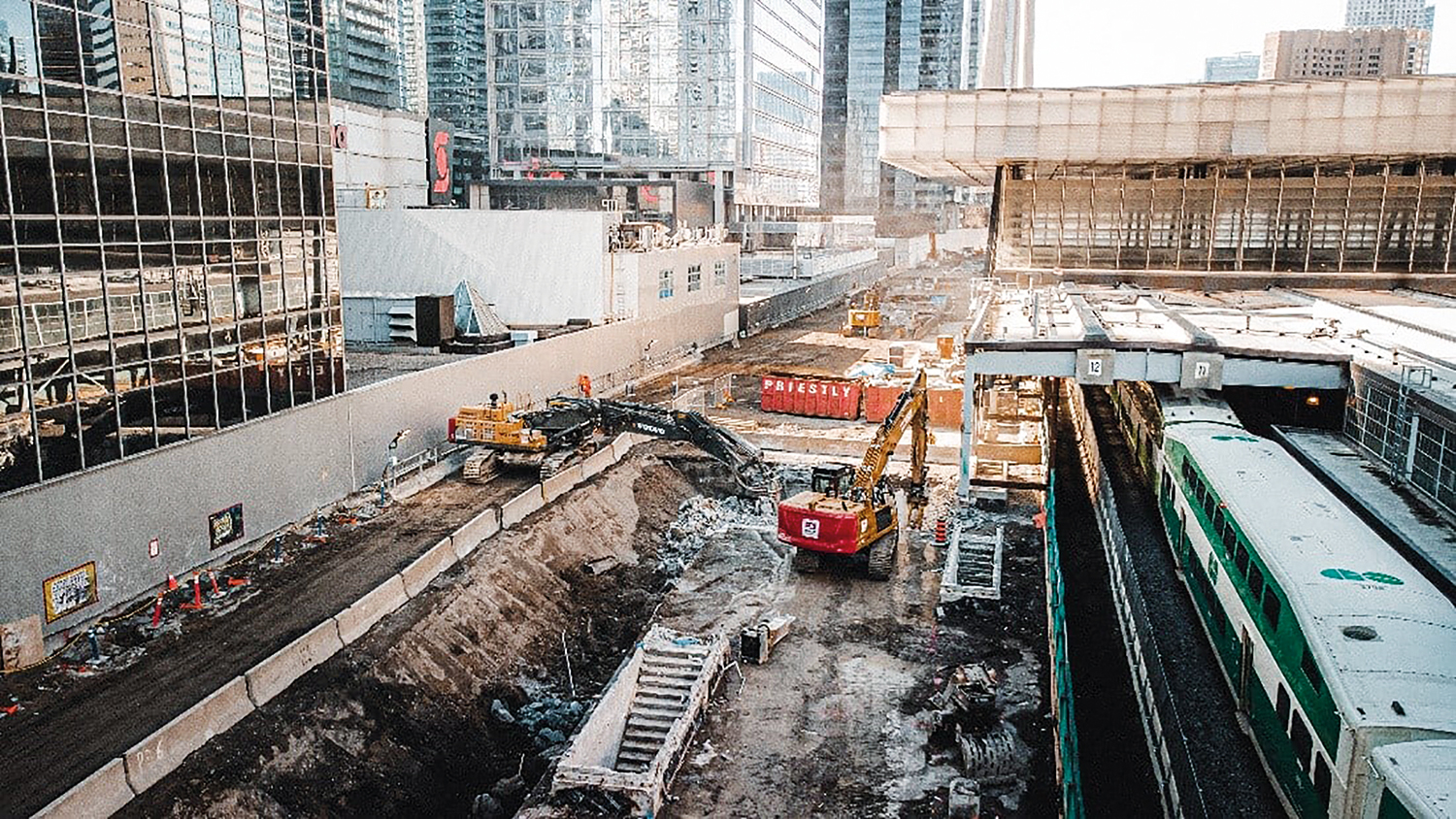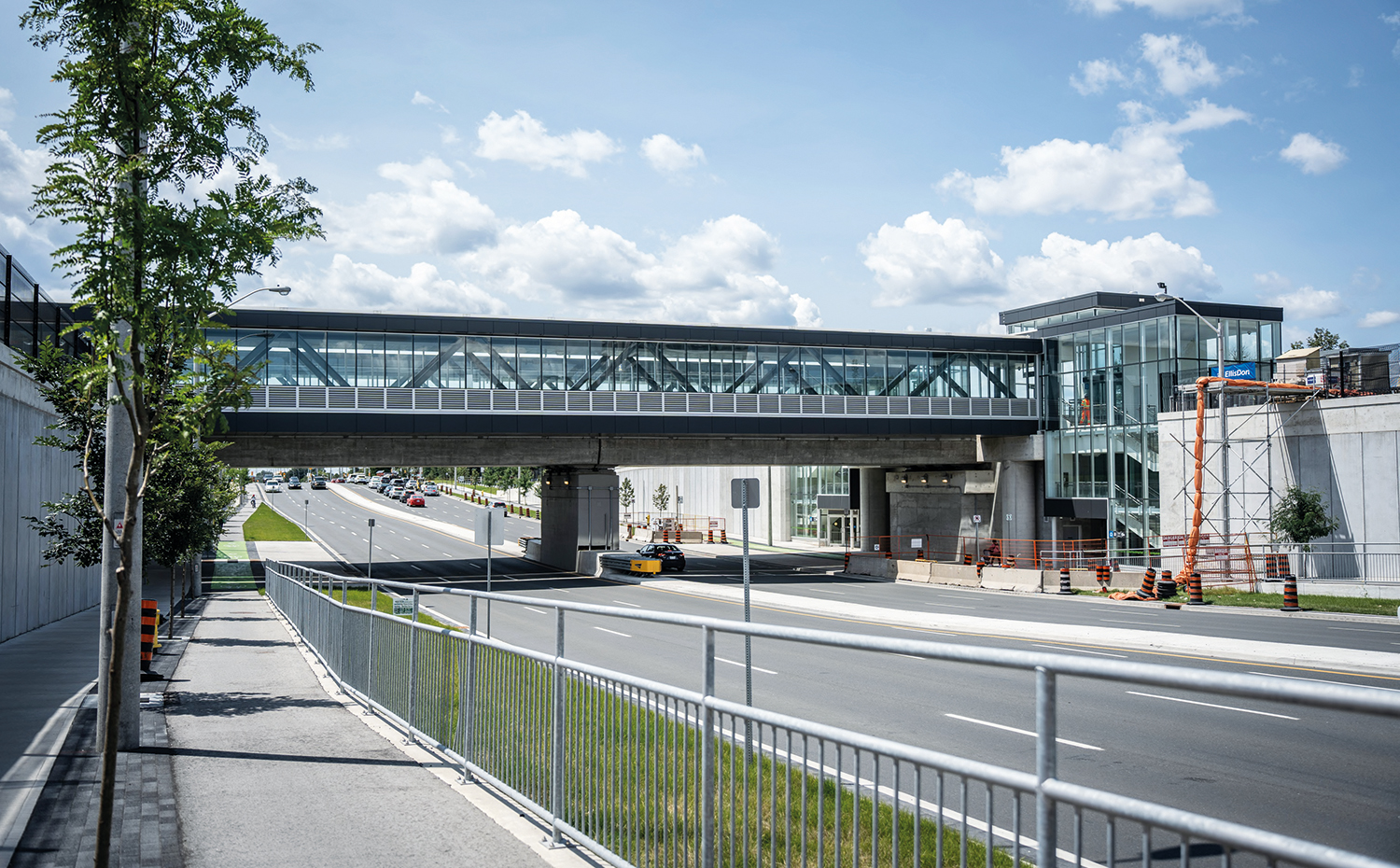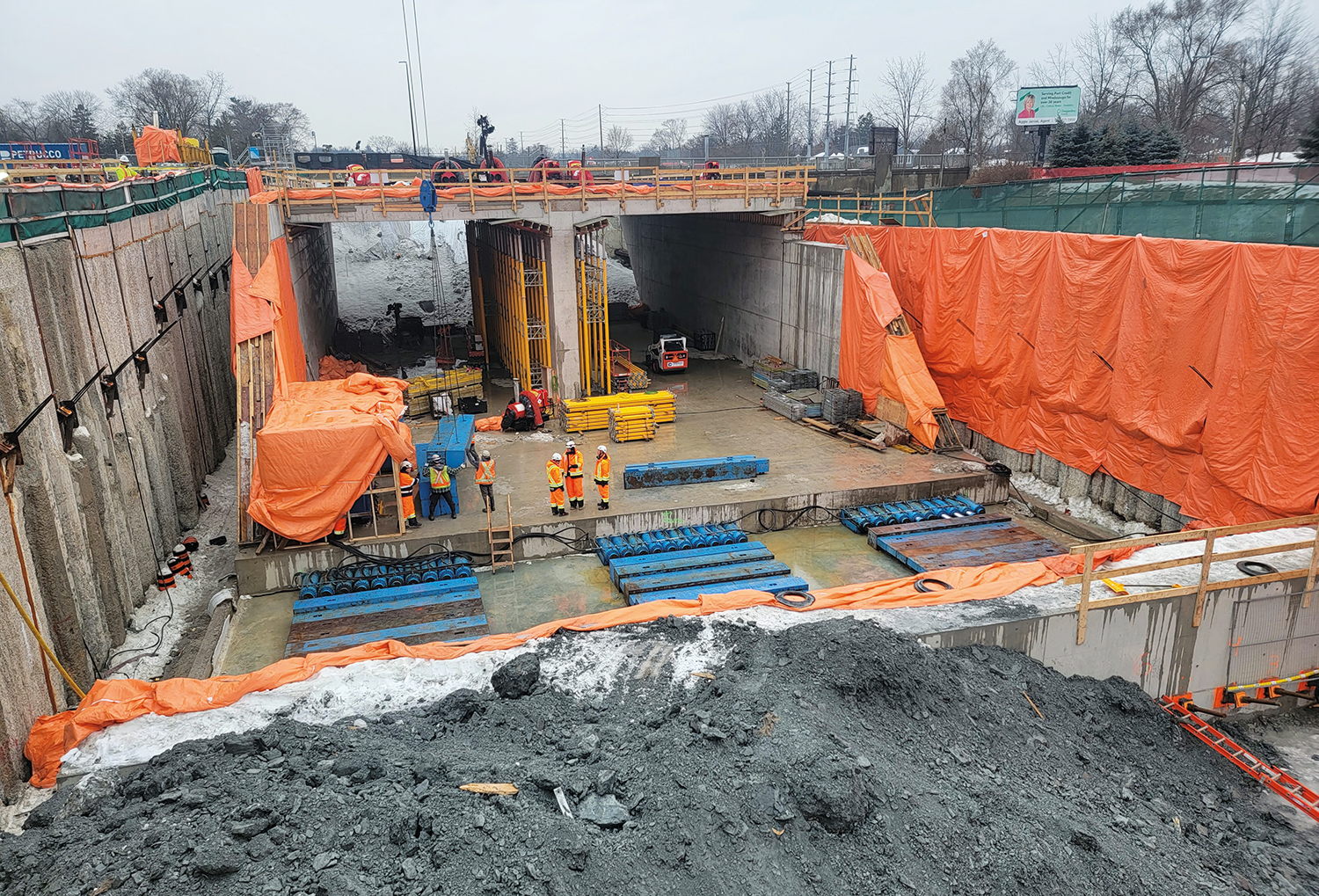
Construction lead on the £10bn GO Expansion transit scheme in Toronto is Iain Thomas FCIOB. He tells Rod Sweet about his role on this vast project.
When Iain Thomas moved from UK to Canada in 2021, he didn’t quite expect to be helping to lead the biggest expansion of a transit network in the Americas.
“My wife and I travelled the world for a year when we first met, and I’d always wanted to live abroad,” he explains.
“I was working for SYSTRA in the UK, leading major project delivery. SYSTRA had acquired
my previous employer, TSP Projects and, in a weekly MD’s briefing, it was mentioned that in the new business there were opportunities globally, even for project managers in Canada.
“I jumped at the chance, expressing my interest in April 2021, and by August we had sold our house and were heading to Toronto to start our new lives.”
With SYSTRA Canada, Thomas was initially providing constructability support to the team building the Ontario Line, a C$12bn (£7bn) new subway line for Metrolinx with 15 new stations running 15.6km south west to north east through the downtown core out to the Ontario Science Centre.
Delivery partner bid
He was also involved in the final tender stages, and the collaborative behavioural assessments, in its bid to be the programme delivery partner on the GO Expansion programme, a massive new transit project in southern Ontario.
“In March 2022 we found out our joint venture – Mace, Comtech, and SYSTRA (MCS) – had been successful,” Thomas says.
“Our client is Metrolinx, an agency of the Ontario provincial government created to improve the coordination and integration of all modes of transportation in the Greater Toronto and Hamilton Area.

“Estimated at C$18bn (£10.5bn), GO Expansion is Metrolinx’s biggest ever undertaking, and the most extensive transportation investment in the province’s history. The final budgets associated with both the early and complementary works (E&CW) and the on-corridor works are still to be finalised.”
Thomas was appointed head of projects and construction, an MCS role.
The Greater Golden Horseshoe Historically, transport planning in Toronto focused on getting commuters in and out of downtown.
Now, the scope has widened to mobility across what’s called the ‘Greater Golden Horseshoe’, a vast area wrapping around the western end of Lake Ontario, taking in cities and towns from Oshawa in the east, Barrie to the north, Guelph and Kitchener in the west, and Grimsby and Niagara Falls to the south.
Thomas jokes that he was “not the only one who fancied coming here”.
From 1996 to 2021, the Horseshoe’s population increased by 57%, from 6.5 million to an estimated 10.2 million.
Metrolinx’s planning is for 2051, when the area’s population is expected to reach 14.9 million.
Programme overview
More than a rush hour commuter service, GO will offer more services with faster trains, more stations, and seamless connections to the regional rapid transit network.
“Regionally, Metrolinx wants all-day services with trains every 15 minutes or better,” says Thomas. “They typically have higher-speed electric trains that can reach a maximum speed around 120km/h, with fast braking and acceleration to cut the time spent in stations.
“There is no precedent for the GO programme; it’s unlike anything seen before in Canada.”
More than C$11bn (£6.5bn) of early works and off-corridor projects are already underway, including station improvements, grade separations, bridge and tunnel expansions and maintenance facilities.
There are also numerous improvements to the historic Toronto subway (see below).
The works started five years ago and will continue for 10-15 years.
Programme delivery role
As programme delivery partner, MCS has two main jobs, Thomas explains.
“First, we’re bolstering Metrolinx’s processes, including systems, technology and people, so they’re prepared to deliver megaprojects in the future,” he says.

“We base our approach on a ‘sunset model’. This means that at the end of our contract engagement, our MCS team walk off into the sunset leaving a streamlined and experienced Metrolinx organisation to drive forward with future megaprojects.
“Second, we must deliver the E&CW for GO Expansion. We’re the controlling mind for E&CW projects, ensuring they’re on time and budget to enable the upgrades.”
The team gets involved where it’s needed most, says Thomas. He has been acting project director for the Lakeshore East-West grading works, an approximately C$400m (£233m) project widening the rail corridor to accommodate four tracks instead of three.

Iain Thomas CV
2022 to present Head of project and construction delivery, GO Expansion, SYSTRA, Mace and Comtech (MCS) joint venture, Toronto
2021-22 Senior project manager – major projects, SYSTRA Canada
2020-21 Programme manager – major projects, SYSTRA UK
2019-20 Principal project manager, TSP Projects
2017-18 Regional operations manager, Story Contracting
2008-17 Project manager, VINCI Construction UK
2001-08 Site agent/project manager, Morgan Sindall Education
1993-98 University of Northampton, BSc Construction, Economics and Management
“Every day when I wake up over the next six months or so, I’ll be thinking about driving delivery of site works, and improving health, safety, and quality performance on sites,” Thomas explains.
“Also on my mind is how I can coach and mentor the existing teams to improve through the rollout of Lean control boards, Last Planner (a Lean construction methodology), and other techniques.
“We also need to engage more of the wider construction industry because the sheer quantum of work here is massive. We need to widen the pool of tier 1 and 2 contractors, making sure contracts aren’t too complicated for tier 2s to consider committing themselves.”
New ways of working
GO has given Metrolinx the chance to try innovative construction techniques, such as offsite fabrication.
“One of our contractors, Kenaidan, recently built a platform canopy beside the tracks, then lifted it into place in sections over a few nights when the railway was closed,” Thomas says. “It such was a much safer and quicker delivery approach with less impact on the railway and local community, as fabrication works were undertaken on dayshifts.
“Also new technologies being proactively trialled here are automatic train warning and lookout systems. Widely used on Network Rail in the UK, they improve the quantum of time available to work on the corridor.”
Because of the sheer scale of the programme for Metrolinx, they need support from abroad to develop their systems, methods and teams to proactively drive delivery, Thomas adds.
“It’s become a global effort,” he says. “To name a few tier 1s working on GO: SYSTRA and Alstom of France; Mace from the UK; Dragados, Ferrovial and Sacyr from Spain;
and Deutsche Bahn from Germany.
“There is a huge opportunity for experienced expats to get involved and make a big difference.
“I have strong connections with the British Consulate, who are pushing forward with UK-Canada trade agreements and events to show the opportunities for UK firms.
“Perhaps we’ll see you in the Golden Horseshoe before too long!”
Toronto subway expansion

Toronto commuters have not been forgotten and the expansion of the city’s historic subway system stretches comprehension.
As well as the brand new Ontario Line, the Scarborough Subway Extension will push the Toronto Transit Commission’s (TTC) Line 2 subway nearly 8km farther into Scarborough.
The Yonge North Extension will take TTC’s Line 1 north from Finch Station to Vaughan, Markham and Richmond Hill, an extension of around 8km with five stations.
Mixing underground and overground, the Eglinton Crosstown Light Rapid Transit (LRT) scheme is a 19km-long midtown light-rail link between east and west Toronto with 25 stations. It is set to cut the time that journey takes now by 60%, with 10km of the route underground.
In the west, the Eglinton Crosstown West Extension will run 9.2km mostly underground from the future Mount Dennis LRT station to Renforth Drive, to give one LRT line from Scarborough in the east to Mississauga in the west through midtown Toronto.
Boring machines Renny and Rexy are currently digging the twin tunnel east along Eglinton Avenue West toward the Humber River.
North of that, the 18-stop, 10.3km-long Finch West LRT will run along Finch Avenue West from Keele Street to Highway 27, turning south from there to Humber College near Pearson International Airport.
Farther west, the Hazel McCallion LRT will run 18km north-south between Brampton and Mississauga.
In many cases, these subway and LRT extensions will link up with regional railways serving the Horseshoe.











